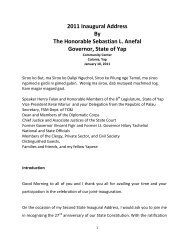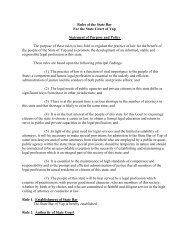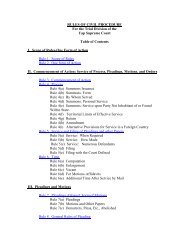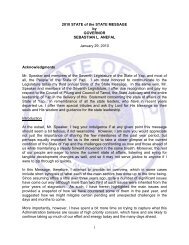CORRIGENDUM No. 2 - Yap State Government
CORRIGENDUM No. 2 - Yap State Government
CORRIGENDUM No. 2 - Yap State Government
Create successful ePaper yourself
Turn your PDF publications into a flip-book with our unique Google optimized e-Paper software.
INTRODUCTION<br />
Four major issues arise when designing a system:<br />
1. the load (power) required to be supplied by the system is not constant over the period of one day;<br />
2. the daily energy usage varies over the year;<br />
3. the energy available from the PV array may vary from time to time during the day;<br />
4. the energy available from the PV array will vary from day to day during the year.<br />
Since the system is based on photovoltaic modules, then a comparison should be undertaken between the<br />
available energy from the sun and the actual energy demands The worst month is when the ratio between<br />
solar energy available and energy demand is smallest.<br />
The design of an off-grid power requires a number of steps. A basic design method follows:<br />
1. Determination of the energy usage that the system must supply.<br />
2. Determination of the battery storage required.<br />
3. Determination of the energy input required from the PV array or other sources (eg battery<br />
charger/generator)<br />
4. Selection of the remainder of system components.<br />
LOAD (ENERGY) ASSESSMENT<br />
Electrical power is supplied from the batteries (DC) or via an inverter to produce either 230 volts AC (South<br />
Pacific) or 110 / 120 volts AC (<strong>No</strong>rth Pacific). Electrical energy usage is normally expressed in watt hours (Wh)<br />
or kilowatt hours ( kWh ).<br />
To determine the daily energy usage for an appliance, multiply the power of the appliance by the number of<br />
hours per day it will operate. The result is the energy (Wh) consumed by that appliance per day.<br />
Appliances can either be DC or AC. An energy assessment should be undertaken for each type, examples of<br />
these are shown in tables 1 and 2.<br />
You need to calculate the electrical energy usage with the customer. Many systems have failed over the years<br />
not because the equipment has failed or the system was installed incorrectly, BUT BECAUSE THE<br />
CUSTOMER BELIEVED THEY COULD GET MORE ENERGY FROM THEIR SYSTEM THAN THE SYSTEM<br />
COULD DELIVER. It failed because the customer was unaware of the power/energy limitations of the<br />
system.<br />
The problem is that the customer may not want to spend the time determining their realistic power and energy<br />
needs which is required to successfully complete a load assessment form. They just want to know: How much<br />
for a system to power my lights and TV<br />
A system designer can only design a system to meet the power and energy needs of the customer. The<br />
system designer must therefore use this process to understand the needs of the customer and at the same<br />
time educate the customer. Completing a load assessment form correctly (Refer to table 1 and 2 below) does<br />
take time; you may need to spend 1 to 2 hours or more with the potential customer completing the tables. It is<br />
during this process that you will discuss all the potential sources of energy that can meet their energy needs<br />
and you can educate the customer on energy efficiency.<br />
Issue 1 September 2012 Page 2
















